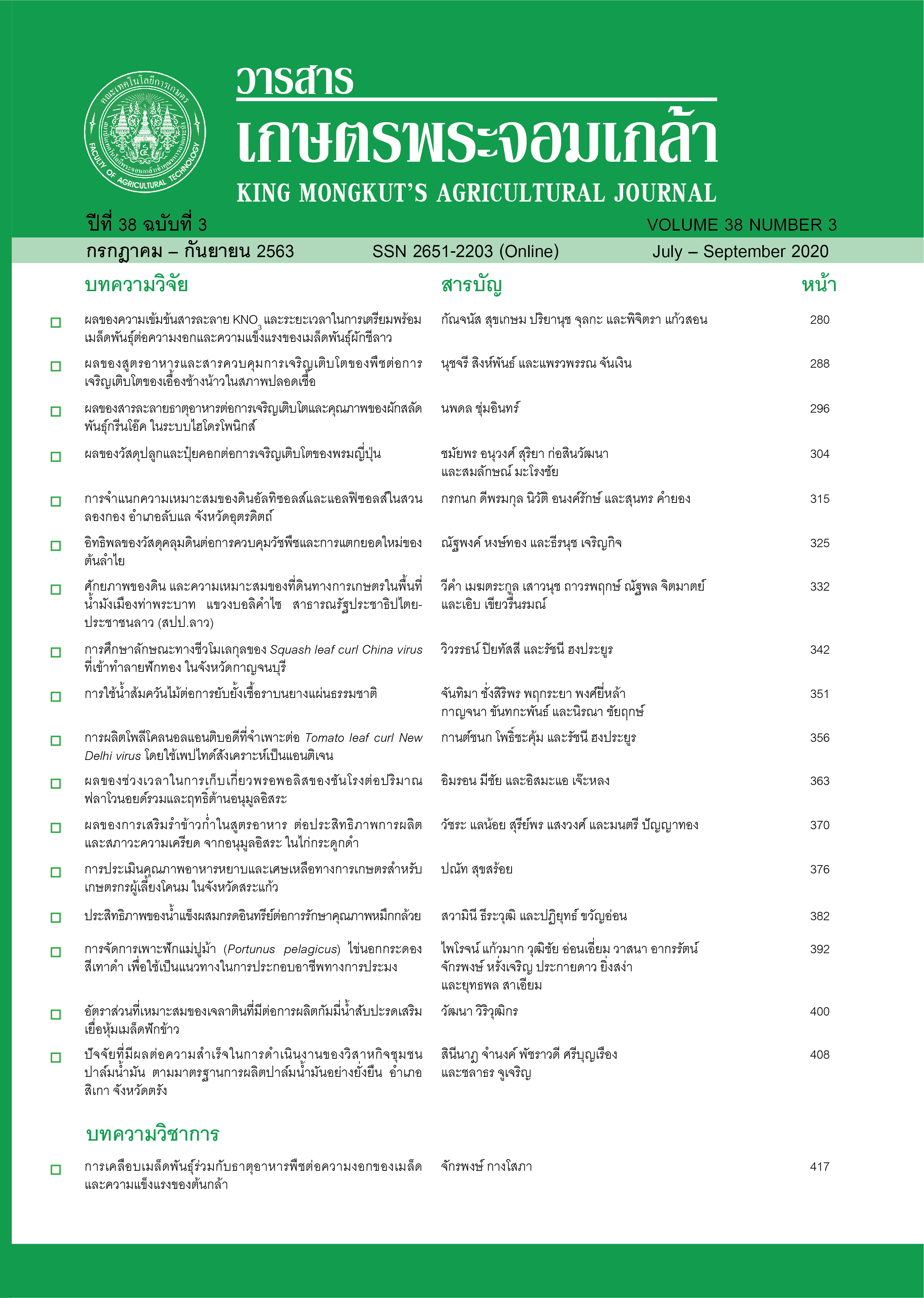ผลของการเสริมรำข้าวก่ำในสูตรอาหาร ต่อประสิทธิภาพการผลิต และสภาวะความเครียด จากอนุมูลอิสระ ในไก่กระดูกดำ
Main Article Content
บทคัดย่อ
งานวิจัยนี้เป็นการศึกษาผลของการใช้รำข้าวก่ำในอาหารต่อประสิทธิภาพการผลิต และสภาวะความเครียดจากอนุมูลอิสระของไก่กระดูกดำ ลูกไก่กระดูกดำอายุ 1 สัปดาห์ จำนวน 200 ตัว แบ่งออกเป็น 5 กลุ่ม ๆ ละ 40 ตัว ในแต่ละกลุ่มให้อาหารพื้นฐานที่มีข้าวโพดและกากถั่วเหลืองเป็นองค์ประกอบหลัก เสริมด้วยรำข้าวก่ำ 0% (กลุ่มควบคุม), 3%, 6%, 9% และ 12% ตามลำดับ การให้อาหารแบ่งเป็น 2 ระยะ (1-3 สัปดาห์ และ 4-16 สัปดาห์) ค่าความสามารถในการกำจัดอนุมูลอิสระ (ORAC) ของสูตรอาหารเพิ่มขึ้นตามปริมาณของรำข้าวก่ำที่เพิ่มขึ้น ประสิทธิภาพการผลิตของไก่กระดูกดำที่เลี้ยงด้วยรำข้าวก่ำไม่มีความแตกต่างกับกลุ่มควบคุมอย่างมีนัยสำคัญ อย่างไรก็ตามน้ำหนักตัวที่เพิ่มขึ้น (body weight gain, WG) ในกลุ่มที่เสริมรำข้าวก่ำมีแนวโน้มสูงกว่ากลุ่มควบคุม แต่ต้นทุนค่าอาหาร (feed cost per gain, FCG) ในกลุ่มที่เสริมรำข้าวก่ำสูงกว่ากลุ่มควบคุม ปริมาณ malondialdehyde (MDA) ในเลือด สัปดาห์ที่ 4, 8, 12 และ 16 ของไก่กระดูกดำที่เสริมรำข้าวก่ำมีค่าต่ำกว่า
กลุ่มควบคุมอย่างมีนัยสำคัญ (P<0.05) ระดับ MDA ในเนื้อส่วนอกหลังจากเก็บไว้ที่อุณหภูมิ 4°C ในวันที่ 1, 3, 6 และ 9 ของ
ไก่กระดูกดำที่เสริมรำข้าวก่ำไม่มีความแตกต่างกับกลุ่มควบคุมอย่างมีนัยสำคัญ ผลการศึกษาครั้งนี้สรุปได้ว่าการเสริมรำข้าวก่ำในอาหารไม่มีผลกระทบต่อประสิทธิภาพการผลิตของไก่กระดูกดำ แต่มีผลทำให้ระดับความเครียดจากอนุมูลอิสระลดลง และไม่มีผลต่อการเกิด lipid oxidation ในเนื้อหน้าอกที่ผ่านการเก็บรักษา
Article Details
วารสารเกษตรพระจอมเกล้า
เอกสารอ้างอิง
Chen, P. N., S. C. Chu,H. L.Chiou,W. H.Kuo, C. L. Chiang and Y. S. Hsieh. 2006. Mulberry anthocyanins, cyanidin 3-rutinoside and cyanidin 3-glucoside, exhibited an inhibitory effect on the migration and invasion of human lung cancer cell line. Cancer Letters 235: 248-259.
Ismail, H. A., E. J. Lee, K. Y.Ko and D. U.Ahn. 2008. Effects of aging time and natural antioxidants on color, lipid oxidation and volatiles of irradiated ground beef. Meat Science 80: 582-591.
Mielnik, M. B., E. Olsen,G. Vogt, D. Adeline and G. Skrede. 2006. Grape seed extract as antioxidant in cooked, cold stored turkey meat. LWT. 39: 191-198.
Punyatong M., P. Pongpiachan, P. Pongpiachan, Y. Pongpibul, and S. Mankhetkorn. 2010. Effects of Gamma oryzanol and Proanthocyanidin from purple glutinous rice bran (Oryza sativa L.) on antibody production and oxidative status in oxidative stress BALB/c mice. Inter J Curr Trends Sci Tech 1(1): 42–52.
Punyatong, M. 2009. Antiproliferative action and increase of antibody production with gamma oryzanol and proanthocyanidin from purple glutinous rice.Thesis Doctor of Philosophy in Biotechnology.The Graduate School, Chiang Mai University. 147p.
Santos, M. T., J. Valles, J. Aznar and J. Vilches. 1980. Determination of plasma malondialdehyde-like material and its clinical application in stroke patients.J. Clin. Pathol. 33: 973-976.
Simitzis, P. E., G. K. Symeon, M. A. Charismiadou, J. A. Bizelis and S. G. Deligeorgis. 2010. The effect of dietary oil supplementation on pig meat characteristics.Meat Science 84: 670-676.
Wen, H. L., L. L. Wang and J. Ma.2002. Supplementation of the black rice outer layer fraction to rabbits decreases atherosclerotic plaque formation and increases antioxidation status. J. Nutr. 132: 20-26.
Wojdylo, A., J. Oszmianski and R. Czemerys. 2007. Antioxidant activity and phenolic compounds in 32 selected herbs. Food Chemistry 105: 940-949.
Zhu, W. Q., H.F. Li, J.Y. Wang, J.T. Shu, C.H. Zhu, W.T. Song, C. Song, G.G. Ji and H.X. Liu. 2014. Molecular genetic diversity and maternal origin of Chinese black-bone chicken breeds. Genetic and Molecular Research(2): 3275-3282.


